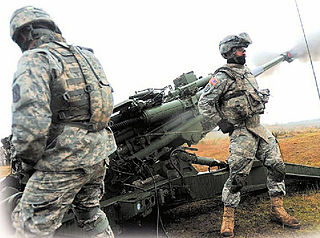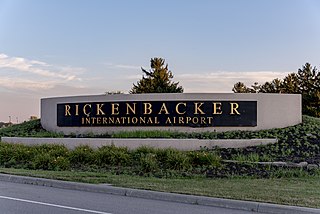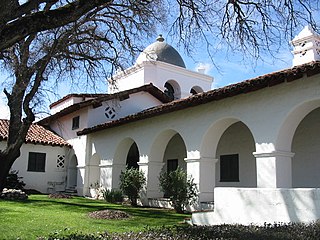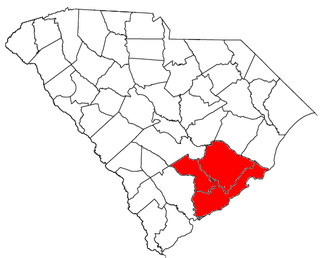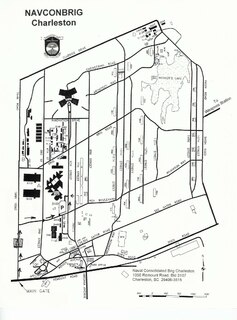United States Army Reserve Center, Rio Vista is a former United States Army Reserve center located in Rio Vista, Solano County, California. It was established in 1911 as the U.S. Engineers Storehouse, Rio Vista. It went through ten different names in its 81-year history, finally becoming the United States Army Reserve Center, Rio Vista California. It was closed in 1992 as a result of a BRAC recommendation. [1]

The United States Army Reserve (USAR) is a reserve force of the United States Army. Together, the Army Reserve and the Army National Guard constitute the Army element of the Reserve components of the United States Armed Forces.

Rio Vista is a city located in the eastern end of Solano County, California, in the San Francisco Bay Area—either in the East Bay or the North Bay, depending on what definition is used—on the Sacramento River, in the Sacramento River Delta region. The population was 7,360 at the 2010 census.

Solano County is a county located in the U.S. state of California. As of the 2010 census, the population was 413,344. The county seat is Fairfield.
The base is located on a 28-acre (11 ha) property south of town, on the west bank of the Sacramento River. It was acquired on July 21, 1911 by the U.S. Army Corps of Engineers to support the work of the Corps in dredging, clearing, and surveying the Sacramento River. The Corps had been working on the river since 1875, deepening it, straightening it, and removing obstacles such as trees, shoals, and even a 100-acre island which they completely eliminated. The goals of this work were to prevent flooding, make the river more navigable, and reclaim farmland. The base was used to house, store, or moor equipment, including the large suction barges used for these purposes. [2]
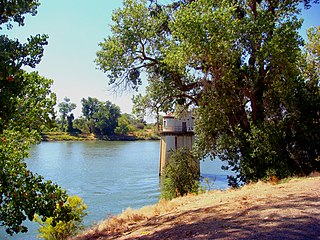
The Sacramento River is the principal river of Northern California in the United States, and is the largest river in California. Rising in the Klamath Mountains, the river flows south for 400 miles (640 km) before reaching the Sacramento–San Joaquin River Delta and San Francisco Bay. The river drains about 26,500 square miles (69,000 km2) in 19 California counties, mostly within the fertile agricultural region bounded by the Coast Ranges and Sierra Nevada known as the Sacramento Valley, but also extending as far as the volcanic plateaus of Northeastern California. Historically, its watershed has reached as far north as south-central Oregon where the now, primarily, endorheic (closed) Goose Lake rarely experiences southerly outflow into the Pit River, the most northerly tributary of the Sacramento.
The facility expanded over the next several decades, with additional buildings and even a marine railway. During World War II the function of the base shifted to focus on harbor serving vessels such as floating cranes, barges, tugs and small freighters. For this reason the base was reassigned to the U.S. Army Transportation Corps in 1952 with the primary function of storing and maintaining Army harbor craft. The facility's name was changed several times during the 1950s and 1960s. It reached peak activity in 1963 when it was reported to have 300 civilian employees and 350 vessels. [2]
In 1963 a 4-acre (1.6 ha) parcel at the southern end of the facility was transferred to the U.S. Coast Guard to construct a Coast Guard station which is still in operation. [3]
Activity at the base increased during the Vietnam War. In 1967 the base, now called the Rio Vista Marine Storage Activity, was placed under the command of Sharpe Army Depot. Its primary function was to prepare amphibious vehicles for shipment to Vietnam. Also in 1967 the base was unexpectedly pressed into local service when a freighter struck a local bridge and cut it in half. For the next several weeks while the bridge was being repaired, an Army LCM amphibious vehicle from the base was used as a "foot ferry", transporting residents back and forth across the river to attend school, go to work, and attend to other needs on the other side of the river. [4]

The Vietnam War, also known as the Second Indochina War, and in Vietnam as the Resistance War Against America or simply the American War, was a conflict in Vietnam, Laos, and Cambodia from 1 November 1955 to the fall of Saigon on 30 April 1975. It was the second of the Indochina Wars and was officially fought between North Vietnam and South Vietnam. North Vietnam was supported by the Soviet Union, China, and other communist allies; South Vietnam was supported by the United States, South Korea, the Philippines, Australia, Thailand and other anti-communist allies. The war, considered a Cold War-era proxy war by some, lasted 19 years, with direct U.S. involvement ending in 1973, and included the Laotian Civil War and the Cambodian Civil War, which ended with all three countries becoming communist in 1975.
In 1974 the base was renamed Rio Vista Storage Activity Site and control was transferred to the Presidio of San Francisco. Its mission was changed to Logistics Over The Shore (LOTS) operations training. In 1971 the USAT Resolute, a 338-foot (103 m) cargo and training ship, was moved to the Rio Vista facility.

The Presidio of San Francisco is a park and former U.S. Army military fort on the northern tip of the San Francisco Peninsula in San Francisco, California, and is part of the Golden Gate National Recreation Area.

USS Pembina (AK-200) – later known as USNS Pembina (T-AK-200) -- was an Alamosa-class cargo ship that was constructed for the U.S. Navy during the closing period of World War II. She supported the end-of-war Navy effort and was subsequently placed in service with the US Army under the Shipping Control Authority for the Japanese Merchant Marine with a Japanese crew in Yokosuka, Japan.
In 1980 the facility was transferred to the U.S. Army Reserve and renamed the Rio Vista United States Army Reserve Center (Rio Vista USAR Center). It was primarily used for training purposes by engineering and transportation units.
In 1992 the facility was closed and all equipment was removed. The city of Rio Vista purchased the property from the federal government in 2003. [4] It remains empty, but the city has proposed a redevelopment plan for the property. [5] Two of the proposed uses are a research and monitoring station to study the river and the Delta, and a fish refuge and fish hatchery. [6] Other proposed new uses include hiking and picnic areas, a boat dock, hotels, and a conference center. [7]

